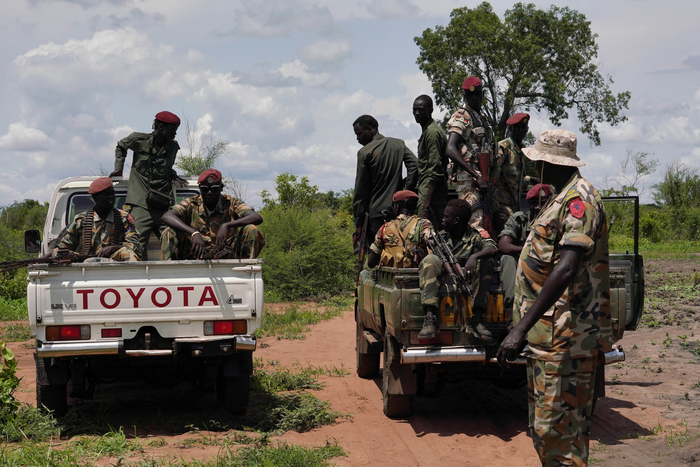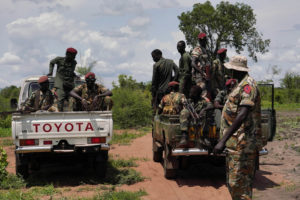Unresolved key issues could still prevent South Sudan’s rival parties from meeting a looming deadline to form a coalition government, while a lack of transparency over how tens of millions of dollars have been spent on forging peace is raising further concerns.
The power-sharing deal signed in 2018 between President Salva Kiir and opposition leader Riek Machar has already been extended twice – in May 2019 and November 2019 – delaying the formal end to a war that has killed nearly 400,000 people, displaced millions, and pushed tens of thousands to the brink of starvation. The new deadline is 22 February.
“There’s still no clear path to forming the unity government in February, for the same reasons the parties missed the previous two deadlines to do so,” Alan Boswell, senior analyst with the International Crisis Group (ICG), told The New Humanitarian. “If the parties don’t agree on a path forward, to extend or not extend this deadline, the deal could break down and fighting could resume.”
Kiir’s spokesman, Ateny Wek Ateny, said the government is committed to peace, and that the coalition government will be formed by the deadline, but he acknowledged there are still issues being negotiated.
“It is not practical to finish the sticking points before the end of 100 days,” Ateny told TNH on Wednesday, referring to the 100-day extension that was given in November and comes to an end with the 22 February deadline.
Key issues stalling the deal are the failure to gather government and rebel forces into a new 83,000-strong unified army, and disagreement over the number of states the country will be divided into – and their boundaries.
There is also an added stumbling block – a lack of transparency on how much money has actually been disbursed for all the resources needed to move the peace deal forward, and questions about the use of the money that was given.
The funding for the implementation of the peace deal has been channelled through the National Pre-Transitional Committee (NPTC), a 10-member group comprising government and opposition members and charged with overseeing the finances of the initial phase of the power-sharing agreement.
Although there have been no public documents that detail how the money has been allocated, TNH has seen internal documents stamped by the NPTC and dated in July that provide a detailed snapshot of how $10 million was supposed to have been allocated. They also raise concerns about potential misappropriation.
Promises made
After the first deadline on forming a coalition government was missed, in May 2019, the government pledged it would contribute $100 million to move the process along. The $100 million was to come from South Sudan’s own revenues, which are mostly derived from oil.
Ateny told TNH on Thursday that a total of $80 million had been disbursed so far. The opposition says it has recorded only $70 million.
How that money has been spent remains unclear.
“People are asking: where is that money, why hasn’t it shown up yet, and what is the government spending it on?” US Ambassador Thomas Hushek told TNH, citing a lack of mechanisms to meet required “standards for transparency and accountability”.
A significant chunk of the peace deal money was earmarked for integrating, training, and housing and feeding government and opposition forces.
Yet UN peacekeepers, for example, reported on 6 February that they had witnessed “appalling living conditions” in a training centre in Maridi, in the Equatoria region, where 1,400 encamped government and rebel soldiers lacked food, shelter, and medical aid.

Members of Machar’s Sudan People’s Liberation Movement-In Opposition (SPLM-IO) working with the peace deal’s security committees said in January that it would take at least two more months to create a unified force, according to Henry Odwar, SPLM-IO deputy chairman.
Read more → ‘The whole country is traumatised’
Martin Elia Lomuro, secretary to the NPTC, was sanctioned by the United States Treasury in December – a punishment aimed at senior officials accused of “perpetuat[ing] the conflict for their own personal enrichment”.
Lomuro told TNH in October that allegations of mismanagement of peace funds were “rubbish”, and an accountability report would be issued. He did not say, however, who would be issuing the report or when it would be released.
“We are making a holistic peace and it has a cost, which only South Sudan is paying,” he said. “Those who don’t want peace for our people can [say] what they like.”
TNH reached out to Lomuro again prior to publication, but he did not respond.
The documents obtained by TNH have never been made public and were provided by someone familiar with the peace deal and concerned that the government’s lack of financial accountability could hamper the country’s recovery.
Because there has been no detailed breakdown of how the money has been allocated, the documents – which cover only $10 million of the government’s $100 million May pledge – provide the only window into how some of the money was intended to be spent.
The documents show, for example, that in July of last year $4.5 million was earmarked for the cantonment, training, food, shelter, and unification of government and rebel forces.
However, a January internal security report for aid workers seen by TNH said the lack of food, medicine, and logistical support had led to “at least two deaths” in a training camp in the south.
TNH reached out to several people overseeing the implementation of the peace agreement’s security provisions, including the army chief, General Gabriel Jok Riak Makol, who did not respond to repeated calls on questions of how money had been spent to train, feed, and integrate the security forces.
In November, Major General Lul Ruai Koang, a spokesperson for the army, also declined to comment. TNH reached out to Koang again on Wednesday but did not receive a response.
Where was the money meant to go?
The documents seen by TNH showed that $3.7 million of the pledged money was to pay for accommodation, food, transport, and administrative costs – and other more vaguely worded line items – for the groups involved in the implementation of the peace process. This included roughly $18,000 for flight upgrades.
“The peace committee should explain why the sum of $89,000 was spent on a retreat trip to Rome when all expenses on the trip were paid for.”
Nearly $90,000 was also allocated for a visit to Rome in July for three days of meetings, according to the documents. The trip, however, was paid for by the Community of Sant’Egidio, according to its spokesperson, Massimiliano Signifredi. The Catholic association has been involved in numerous peace negotiations.
“The peace committee should explain why the sum of $89,000 was spent on a retreat trip to Rome when all expenses on the trip were paid for,” said Oyet Nathaniel Pierino, an opposition member and part of the National Constitution Amendment Committee – a legal body charged with incorporating the peace agreement into the constitution.
A sum of $350,000 was allocated to “non-alliances forces”, and otherwise unexplained. The group is not mentioned in the peace agreement signed in 2018.
A $500,000 request for payment – in a separate document seen by TNH – was also submitted by the Evangelical Presbyterian Church in Yei, a town in the southwest of the country.
The request letter, sent in July, said the money was for peace talks between the government and the National Salvation Front (NAS), one of the non-signatory parties to the agreement still fighting in Yei River state.
But, according to NAS spokesperson Suba Samuel Manase, the church never conducted any activities with the group. TNH reached out to Archbishop Elias Taban Parangi whose name is on the letter requesting the funds, but he declined to comment. While the documents show the money was requested, it is unclear whether it was ever released.
‘There’s still war outside’
South Sudan has been at war since 2013 – two years after it gained independence. What began as a power struggle between forces loyal to President Kiir and former vice president Machar quickly escalated along ethnic lines and fighting spread across the country.
A ceasefire signed in 2018 has largely held, despite the deadlock. However, regional governments have been accused of not pushing both sides hard enough to reach a final resolution, while donors – especially the United States – have reportedly grown weary of the humanitarian burden.
Almost 200,000 people are still taking shelter in UN-protected camps across the country. Many say they are still too afraid to return to their homes.
“There’s still war outside; it’s not safe,” Nyabac Oyo told TNH in Malakal’s UN-protected site, where she has been living since the war broke out. “Last time, in 2015, we were told we could go home, and we did. Many lost lives.”
Read more → Peace may bring freedom to South Sudan’s child soldiers, but not the help they need
One South Sudan analyst – with close knowledge of the current peace deal but who wasn’t authorised to speak to the media – alleged that the government is not genuinely committed to forming a unified force and is still maintaining a separate army.
“It’s worrying,” the analyst told TNH. “The government’s claiming they are committed to the agreement, but in reality is making very little effort to adhere to security arrangements.”
The issue of state creation is equally thorny. Kiir created 32 states by decree – after initially raising them from 10 to 28 in 2015 – arguing that devolution boosts local development. But the SPLM-IO accuses him of gerrymandering boundaries to benefit his own ethnic group.
A report in December by the Independent Boundaries Commission, a 14-member body created as part of the peace agreement, urged the government to return to the original 10 states – a suggestion rejected by Juba. Regional leaders are to meet later this month to make a final decision.
“D-day seems doomed,” Odwar, the opposition deputy chairman, told TNH, in reference to the deadline.
Lack of transparency
The United States, the United Kingdom, and the European Union – the country’s main foreign donors – have largely shied away from directly financing the power-sharing agreement, specifically the cantonment sites and military integration.
“We keep hearing different numbers of how much has been disbursed from the government to the NPTC, and there is no clarity on how the money disbursed to date has been spent,” said one foreign diplomat based in Juba who spoke to TNH on condition of anonymity given the sensitivity of the topic.
“This is bad for donor confidence in the process but also for [the] confidence of the population,” said the envoy.
There is no consensus within the NPTC on how much money has actually been received.
Odwar, who is also deputy chairman of the NPTC, confirmed there has been “no transparency” in the use of the funds, and no discussions involving all committee members on how to appropriate the money.
South Sudan’s ceasefire, meanwhile, is fragile, and violence has been flaring.
The UN’s South Sudan envoy, David Shearer, warned in January of a “worrying escalation” of political unrest in Maiwut, in the northeast, and a rise in forced recruitment across the country.
“South Sudan has an abundance of natural resources and enough money for its people to pull them out of poverty,” said Wol Deng Atak, a former lawmaker and journalist whose newspaper was closed down in 2016 after publishing an article on alleged government corruption.
“But, unfortunately, putting money towards its citizens isn’t the priority of the governing party.”



